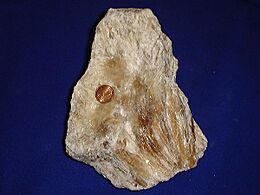Trona facts for kids
Quick facts for kids Trona |
|
|---|---|
 |
|
| General | |
| Category | Carbonate mineral |
| Formula (repeating unit) |
Na2CO3·NaHCO3·2H2O |
| Strunz classification | 5.CB.15 |
| Crystal symmetry | C2/c (no. 15) |
| Identification | |
| Color | Colorless (in transmitted light) or white, grey-white, also grey to yellowish grey, light yellow |
| Crystal habit | Columnar, fibrous and massive. |
| Crystal system | Monoclinic |
| Cleavage | [100] perfect, [111] and [001] indistinct |
| Fracture | Brittle – subconchoidal |
| Mohs scale hardness | 2.5 |
| Luster | Vitreous |
| Streak | White |
| Diaphaneity | Translucent |
| Specific gravity | 2.11–2.17 |
| Optical properties | Biaxial (−) |
| Refractive index | nα = 1.412 nβ = 1.492 nγ = 1.540 |
| Birefringence | δ = 0.128 |
| Solubility | Soluble in water |
| Other characteristics | May fluoresce under short wavelength ultraviolet |
Trona is a natural mineral that forms from evaporated water. Its scientific name is trisodium hydrogendicarbonate dihydrate, or Na2CO3·NaHCO3·2H2O. This mineral is very important in the United States because it is the main source of sodium carbonate, also known as soda ash. Soda ash is used to make many everyday products. Trona is also found and mined in other countries like Turkey.
Contents
What is Trona and Where Does its Name Come From?
The name "trona" came into English from either Swedish or Spanish. Both these words mean the same thing: a mineral called natron from North Africa. The Spanish and Swedish words came from the Arabic word trōn. This word, in turn, came from an older Arabic word natron, which has roots in ancient Hebrew, Greek, and Egyptian words. All these words referred to a natural salt mineral.
Where Can You Find Trona?
Trona is found in special places where ancient lakes dried up, leaving behind layers of minerals. These are called evaporite deposits.
- In California, USA, you can find trona at Owens Lake and Searles Lake.
- The Green River Formation in Wyoming and Utah has the largest known trona deposit in the world. Here, trona was laid down in a large lake millions of years ago.
- In Africa, trona is found in the Makgadikgadi Pans in Botswana, the Nile Valley in Egypt, Lake Magadi in Kenya, and Lake Natron and Etosha National Park in Namibia.
- In Turkey, the Beypazari region near Ankara has many layers of trona.
- In China, the Wucheng basin in Henan Province also has deep layers of trona.
What is Trona Used For?
Trona is a very useful mineral with many important applications.
- Making Soda Ash: Trona is the main source of soda ash. Soda ash is a key ingredient in making glass, different chemical products, paper, detergents (like laundry soap), and textiles (fabrics).
- Water Treatment: It helps to condition or treat water, making it suitable for various uses.
- Cleaning Air: Trona can be used to remove sulfur from flue gases, which are gases released from industrial processes, and from certain types of coal. This helps to clean the air.
- Capturing Carbon: It can also be used in processes that capture carbon dioxide from flue gases, helping to reduce greenhouse gas emissions.
- Food Additive: In small amounts, trona is even used as an additive in some foods.
Who Mines Trona?
Many companies around the world are involved in mining trona and processing it into soda ash. Some of these include:
- Rio Tinto – Owens Lake
- Magadi Soda Company
- Searles Valley Minerals Inc.
- Solvay
- Tata Chemicals
- Genesis Alkali
- General Chemical
- Ciner Wyoming
- ANSAC
- Eti Soda, Turkey
- Kazan Soda Elektrik, Turkey
- Church & Dwight – Green River Mine
- Intrepid Potash
- Simplot
See also
- Natron
- Nahcolite
- Shortite
- Sodium sesquicarbonate
- Thermonatrite
Images for kids



